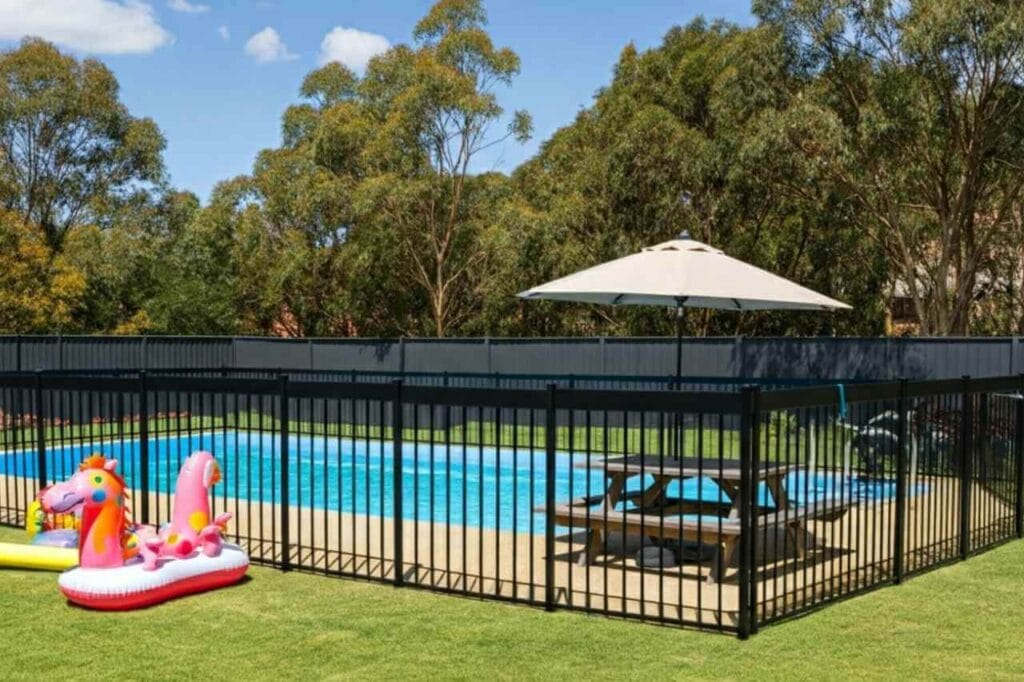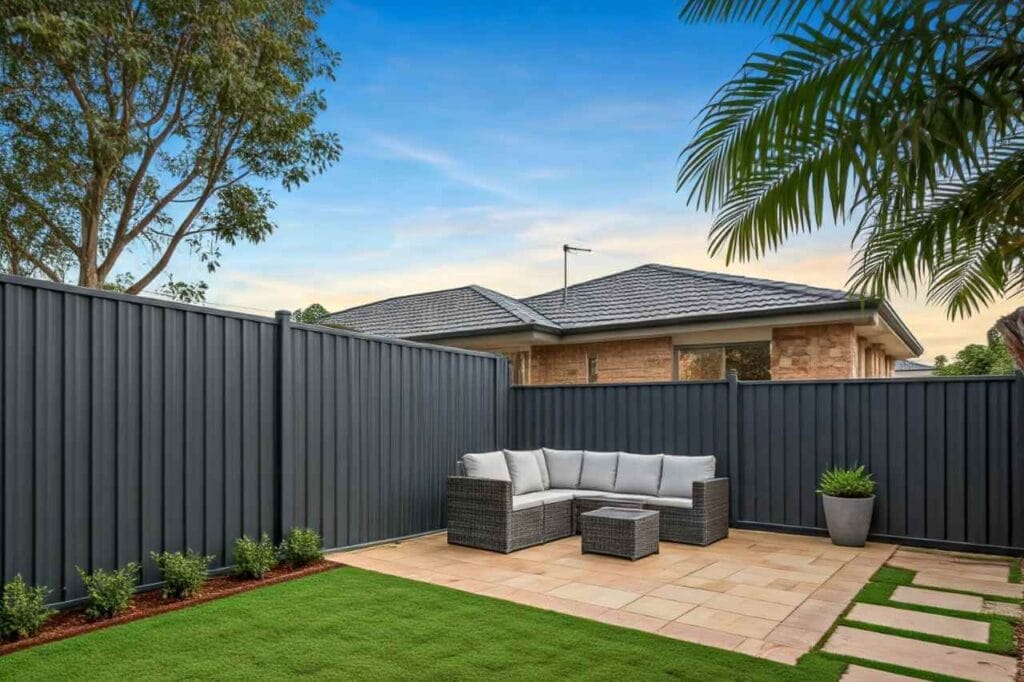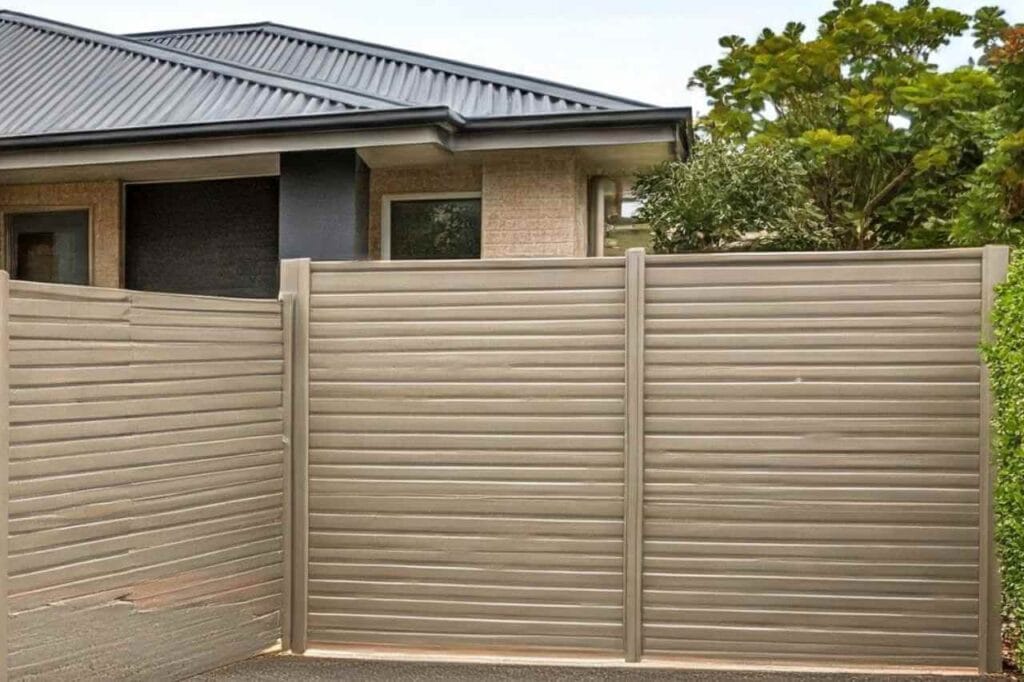How much does it cost to install a fence? Anywhere from $50 to $600 per metre, depending on materials, design, and labour. A basic timber fence is affordable. A glass pool fence? That’s a high-end investment. But the real cost isn’t just the price per metre—it’s how long it lasts and how well it protects your property.
At Pro Fencing Gold Coast, we don’t just install fences—we deliver a fencing solution built to last. Our fences are designed to withstand the harsh Gold Coast climate, providing security, durability, and style.
This guide covers everything you need to know—fencing materials, labour costs, DIY vs. professional installation, and hidden expenses like permits and site preparation. By the end, you’ll know exactly what to expect, what to pay, and how to get the best value for your fencing project investment.

Table of Contents
ToggleHow Much Does Fencing Cost on the Gold Coast?
Fencing prices aren’t one-size-fits-all. Material, height, design, and installation method all play a role in the final cost. A basic timber fence won’t cost the same as a custom-designed glass or wrought iron fence. The real question isn’t just how much it costs upfront—it’s how much value it delivers over time.
Average Fencing Costs Per Metre on the Gold Coast
Here’s a breakdown of estimated type of fencing costs per metre, comparing material-only prices vs. full installation costs:
| Fence Type | Cost Per Metre (Materials Only) | Cost Per Metre (Installed) | Maintenance Level |
|---|---|---|---|
| Timber Fencing | $50 – $120 | $100 – $250 | High (needs staining, termite protection) |
| Colorbond Fencing | $70 – $200 per panel | $120 – $300 | Low (rust-resistant, durable) |
| PVC Fencing | $190 – $250 | $220 – $350 | Very Low (no painting, weatherproof) |
| Wrought Iron | $450+ | $500 – $700 | Medium (needs rust protection) |
| Chain Link Fencing | $70 – $120 per 15m roll | $100 – $180 | Low (basic cleaning needed) |
| Glass Pool Fencing | $200 – $600 | $300 – $800 | Low (occasional cleaning) |
Prices for fencing can vary widely depending on factors like height, location, and additional features such as gates or decorative elements.
Labour Costs for Fencing Installation on the Gold Coast
Hiring a fencing contractor? Expect to pay $50 to $150 per hour, depending on the complexity of the job. Simple, straight-line fences on flat land? Lower end of the scale. Custom designs, sloped terrains, or premium materials? That’s where costs go up.
DIY can cut labour costs, but precision matters. A poorly installed fence won’t last, and if it doesn’t meet council regulations, you’ll be paying twice—once to build it, and again to fix it.
Hidden Costs to Consider
Fencing costs don’t stop at materials and labour. Here’s what else can impact your final bill:
- Site Preparation – Removing old fencing, clearing debris, or levelling uneven ground.
- Permits & Council Fees – Required for fences over 2 metres, pool fencing, and some boundary fences.
- Gates & Extras – Entry gates, decorative elements, or security features all add to the price.

Cost Breakdown by Fence Type
Not all fences are built the same. Different materials offer different benefits, lifespans, and price points. Here’s what you need to know before choosing the right one for your home.
1. Timber Fencing
- Pros: Budget-friendly, natural look, customisable designs.
- Cons: Needs regular upkeep—painting, sealing, and termite protection.
- Best for: Traditional homes, rural properties, cost-conscious Australian homeowners.
- Lifespan: 10-15 years with proper care.
2. Colorbond Fencing
- Pros: Strong, weather-resistant, comes in multiple colours.
- Cons: Can dent under impact, reflects heat onto nearby gardens.
- Best for: Modern homes,privacy fencing, coastal areas.
- Lifespan:20-30 years.
3. PVC Fencing
- Pros: No rust, no painting, built to withstand harsh coastal conditions.
- Cons: Higher upfront cost compared to timber or Colorbond.
- Best for: Coastal properties, Hamptons-style homes, low-maintenance solutions.
- Lifespan: 30+ years.
4. Wrought Iron Fencing
- Pros: Extremely strong, can be customised for intricate designs.
- Cons: Expensive, requires rust protection in salty air.
- Best for: Luxury homes, heritage-style properties, high-security needs.
- Lifespan: 50+ years with maintenance.
5. Chain Link Fencing
- Pros: Affordable, ideal for large areas, quick to install.
- Cons: Zero privacy, industrial appearance.
- Best for: Security fencing,commercial properties, large rural spaces.
- Lifespan: 15-20 years.
6. Glass Pool Fencing
- Pros: Sleek, modern design, required for pool safety compliance.
- Cons: Expensive, requires regular cleaning to keep it looking sharp.
- Best for: Homes with plunge pools or swimming pools, high-end properties.
- Lifespan: 20+ years.
Factors Affecting Fencing Costs on the Gold Coast
Fencing costs aren’t just about materials. Installation, maintenance, and site conditions all play a role in the final price. Here’s what drives total costs up—or keeps them down.
Material Costs – The Biggest Factor
- Timber – Cheap upfront, but needs ongoing maintenance to fight rot and termites.
- Colorbond –Low-maintenance and durable, making it a Gold Coast favourite.
- PVC – Sleek, modern, and long-lasting, but comes with a higher price tag.
- Glass – High-end aesthetic, perfect for pool areas, but requires professional installation.
Installation Costs
- Flat, even ground? Lower costs. Sloped or uneven terrain? Expect extra labour charges.
- Bulk discounts apply to longer fences, but smaller fencing projects cost more per metre.
- Custom designs, decorative fence panels, or gates? All add to the final bill.
Maintenance & Long-Term Costs
- Timber fences need staining and sealing every few years.
- Metal fences may need rust prevention in coastal areas.
- PVC and Colorbond are nearly maintenance-free, making them the most cost-effective over time.
Gold Coast-Specific Regulations & Permits
Fencing isn’t just about picking materials and hiring a contractor. Local council regulations dictate what you can and can’t build—from height limits to boundary agreements and strict pool fencing laws. Ignore them, and you could be facing fines, legal disputes, or a forced rebuild.
Fencing Laws & Regulations on the Gold Coast
Who Pays for a Shared Fence? (Boundary Fencing Laws)
Queensland law is clear—if a fence sits on the shared boundary, both property owners must split the cost equally. But there are exceptions:
- Want a higher, premium, or decorative fence? The person requesting the upgrade pays the difference.
- Fence damaged by negligence (tree roots, car damage, etc.)? The responsible party foots the bill.
- Written agreements prevent disputes—always document any agreements before starting work.
If a neighbour refuses to pay their share, refer to the Queensland Neighbourhood Disputes (Dividing Fences and Trees) Act 2011. If needed, dispute resolution through QCAT (Queensland Civil and Administrative Tribunal) is an option.
Cut corners on regulations, and you’ll pay for it later. Know the rules before you build.
Fence Height Limits in the Gold Coast
The Gold Coast City Council has restrictions on how high fences can be without requiring special approvals:
| Fence Location | Maximum Height Without Approval |
|---|---|
| Front Yard | 1.2 metres |
| Backyard | 2.0 metres |
| Side Fences | 2.0 metres |
| Pool Fencing | 1.2 metres (with strict safety requirements) |
If you want a higher fence, you may need to apply for council approval.
When Do You Need a Permit for Fencing?
Not every fence needs approval, but if you’re building beyond standard regulations, permits are mandatory. You’ll need council approval if:
- Your fence is over 2 metres high (or 1.2 metres for front fences).
- You’re installing pool fencing in Australia—must comply with Queensland’s safety standards.
- Your fence is built on top of a retaining wall over 1 metre high.
- It’s a boundary fence on a main road or a heritage-listed property.
For pool fencing, it’s not just about a permit. You must obtain a Pool Safety Certificate to confirm compliance with Queensland’s strict pool fencing laws.

Gold Coast Council Fencing Requirements & Costs
Council Permit Costs for Fencing
The cost of fencing can vary depending on council regulations, especially when permits are required. If your fence exceeds height limits, involves pool safety compliance, or affects a shared boundary, you may need approval before construction begins.
- Standard fencing approval: Cost around $200 – $400
- Pool fencing compliance certificate: Usually cost $40 – $90
- Boundary fence dispute resolution: Cost varies (depends on legal involvement)
Legal Requirements for Pool Fencing
If you own a plunge pool, spa, or swimming pool, your fence must comply with Queensland’s Pool Safety Laws and local regulations to ensure safety and legal compliance. These rules are strict for a reason—to prevent accidents and protect lives. Here’s what your pool fence must include:
- Minimum height: 1.2 metres.
- Gaps no larger than 100mm to prevent children from squeezing through.
- Self-closing, self-latching gate for safety.
- No climbable objects nearby (e.g., furniture, trees, or retaining walls).
Failing to comply? Expect fines and legal action—and worse, a potential safety risk. Get it right the first time.
Common Mistakes Homeowners Make When Installing Fences
Mistakes in fencing aren’t just inconvenient—they’re expensive. Fixing errors after installation means more time, more money, and more frustration. Here’s what trips Australian homeowners up:
- Not checking boundary lines – Install your fence on a neighbour’s property? Now it’s their fence—and you’re in a legal dispute.
- Ignoring council regulations – Build too high or too close to a road? You’ll be forced to modify or tear it down.
- Choosing the wrong materials for coastal conditions – Timber rots, metal rusts, and poor choices don’t last in Gold Coast’s salty air.
Installation Options – DIY vs. Hiring a Professional
You’ve got two choices: Do it yourself or hire a pro. One saves money upfront. The other saves time, stress, and potential fines.
DIY Fence Installation: When Does It Make Sense?
A DIY fence can work if:
- You’ve got construction or landscaping experience.
- The land is flat, with no tricky terrain.
- You want to cut out labour costs ($50 – $150 per hour).
- You’re using lightweight materials like timber or chain-link.
The Challenges of DIY Fencing
- Takes time – A simple backyard fence can stretch into days.
- Physically demanding – Digging post holes, pouring concrete, and aligning panels isn’t light work.
- Regulatory risks – Get it wrong, and Gold Coast Council will make you redo it.
A fence is only as good as its installation. Get it wrong, and you’re paying twice—once for materials, and again for repairs.
When Should You Hire a Professional Fencing Contractor?
Some fences you can DIY. Others? You’ll want a pro. If the job requires precision, compliance, or heavy-duty materials, professional installation isn’t just recommended—it’s necessary.
When to Bring in an Expert:
- The fence involves complex materials like glass pool fencing, Colorbond, or PVC.
- The ground is sloped, uneven, or needs excavation.
- You need council approval or must comply with boundary laws.
- You want a high-quality finish that lasts years—not months.
Why Hiring a Professional Pays Off:
- Saves time and effort – Faster, cleaner, zero headaches.
- Ensures compliance – No risk of council fines or forced rework.
- Built to last – A pro-installed fence handles Gold Coast’s climate better than a rushed DIY job.
Is It Cheaper to Repair a Fence or Install a New One?
Not every broken fence needs replacing. Sometimes, a repair is all it takes. Other times, you’re throwing money at a lost cause.
When a Repair Makes Sense:
- The fence is structurally solid, but a few panels or posts need fixing.
- Timber fences with minor rot can be patched without a full rebuild.
- Chain link fences may only need new posts—not an entire replacement.
When Full Replacement Is the Smarter Move:
- The fence is 15+ years old and falling apart.
- Damage is too severe—rotting timber, rusted metal, or failing foundations.
- You want to upgrade to a better material (e.g., switching from timber to Colorbond).
Cost Comparison: Fence Repairs vs. Replacement
| Repair Type | Estimated Cost |
|---|---|
| Minor fence repairs (small sections, loose fence panels) | $150 – $500 |
| Replacing 5-10 timber slats | $200 – $800 |
| Reinforcing posts on chain link fence | $300 – $700 |
| Full fence replacement | $1,600 – $4,000 |
If repair costs exceed 50% of a new fence, replacement is usually the better option.
Conclusion
A fence isn’t just a boundary—it’s security, privacy, and added value for your home. Whether you go with timber for affordability, Colorbond for durability, or glass for a premium finish, understanding costs, regulations, and installation factors ensures you make the right choice.
Now that you know what affects fencing costs on the Gold Coast, the next step is simple—work with experts who get it right the first time.
At Pro Fencing Gold Coast, we deliver high-quality, long-lasting fences designed for the local climate. Whether you need a privacy fence, pool fencing, or a durable Colorbond solution, we’ve got you covered. Contact us today to get your fencing quotes!
What’s Next To Do?
Visit our next article where, we break down the best fencing options for different neighbourhoods, helping you choose a style that enhances privacy, security, and curb appeal while blending seamlessly with your surroundings.
Frequently Asked Questions (FAQ)
What is the cheapest fencing option for Gold Coast homes?
The most budget-friendly fencing options include:
- Timber fencing – $50 to $120 per metre (but requires maintenance).
- Chain link fencing – $70 to $120 per 15m roll (best for security, not privacy).
- Basic Colorbond fencing – Around $70 to $200 per panel (low maintenance).
How long does a new fence last in Gold Coast’s climate?
Lifespan depends on the material and maintenance:
- Timber fencing – 10 to 15 years (requires regular sealing and termite protection).
- Colorbond fencing – 20 to 30 years (rust-resistant and durable).
- PVC fencing – 30+ years (weatherproof, no rot or rust).
- Glass pool fencing – 20+ years (requires cleaning but lasts long).
Do I need council approval to replace an existing fence?
In most cases,no permit is needed if you’re replacing the same height of the fence and location. However, you may need approval if:
- The installing a new fence is over 2 metres high.
- You’re building near heritage-listed properties.
- The fence is a pool fence (must comply with Queensland’s pool safety laws).
For pool fencing, a Pool Safety Certificate is required to ensure compliance.
How do I split the cost of a new fence with my neighbour?
Under the Queensland Neighbourhood Disputes Act, both neighbours must share the cost of a boundary fence. Steps to follow:
- Discuss the fence replacement with your neighbour.
- Get written quotes from fencing contractors.
- Provide your neighbour with a written notice (if needed).
- Split the cost equally, unless one party wants a more expensive upgrade.
If a neighbour refuses to pay, you can seek mediation or legal action through the Queensland Civil and Administrative Tribunal (QCAT).
What are the best fence materials to withstand coastal conditions?
Gold Coast’s humid and salty air can damage certain materials. The best options for coastal homes are:
- Colorbond fencing – Rust-resistant, durable, and requires minimal maintenance.
- PVC fencing – No rust, rot, or termite damage, making it perfect for coastal weather.
- Aluminium fencing – Lightweight, corrosion-resistant, and long-lasting.
- Glass pool fencing – Weather-resistant but requires regular cleaning.
